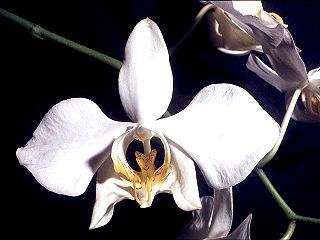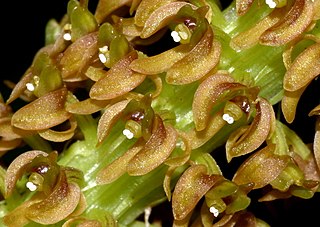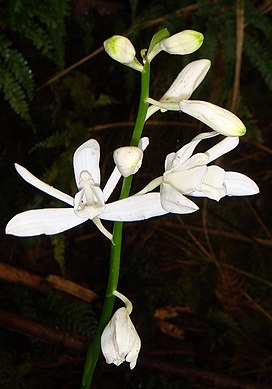
Phalaenopsis amabilis, commonly known as the moon orchid or moth orchid in India and as anggrek bulan in Indonesia, is a species of flowering plant in the orchid family Orchidaceae, native to the East Indies and Australia, and widely cultivated as a decorative houseplant. It is an epiphytic or lithophytic herb with long, thick roots, between two and eight thick, fleshy leaves with their bases hiding the stem and nearly flat, white, long-lasting flowers on a branching flowering stem with up to ten flowers on each branch.

Spathoglottis plicata, commonly known as the Philippine ground orchid, or large purple orchid is an evergreen, terrestrial plant with crowded pseudobulbs, three or four large, pleated leaves and up to forty resupinate, pink to purple flowers. It is found from tropical and subtropical Asia to Australia and the western Pacific including Tonga and Samoa.

Geodorum, commonly known as shepherds' crooks or 地宝兰属 , is a genus of eight species of flowering plants in the orchid family, Orchidaceae. They are deciduous, terrestrial herbs with underground pseudobulbs, broad, pleated leaves and small to medium-sized, tube-shaped or bell-shaped flowers on a flowering stem with a drooping end. Species in this genus are found in southern Japan, tropical Asia, Australia and islands of the southwest Pacific Ocean.

Phaius tankervilleae, commonly known as the greater swamp-orchid, swamp lily, swamp orchid, nun's-hood orchid, nun's orchid, veiled orchid, Lady Tankerville's swamp orchid or 鹤顶兰 , is a species of orchid native to areas from Asia to islands in the Pacific Ocean. It has large, pleated leaves and tall flowering stems bearing up to twenty five white, brown, mauve and yellow flowers. It was named for Lady Tankerville who owned the greenhouse where the first orchid flowered. It was the first tropical orchid to flower in England.

Phaius tankervilleaevar.australis, also known as the common swamp orchid, southern swamp-orchid, swamp lily or island swamp-orchid, is a species of orchid endemic to eastern Australia. It is an evergreen, terrestrial herb with large, crowded pseudobulbs, large pleated leaves and flowers that are reddish brown on the inside and white outside.

Spathoglottis paulinae, commonly known as the small purple orchid, is a plant in the orchid family and is native to New Guinea and Tropical North Queensland. It is an evergreen terrestrial orchid with crowded pseudobulbs, between four and seven large, pleated leaves and up to thirty mauve to purple flowers.

Phaius robertsii, commonly known as forest swamp orchid, is a plant in the orchid family and is native to a small area of Tropical North Queensland and to New Caledonia. It is an evergreen, terrestrial herb with above-ground stems, three to five pleated leaves and up to twenty flowers which are yellow on the back and brick-red inside. It grows in wet places in rainforest.

Dienia ophrydis, commonly known as the common snout orchid or 无耳沼兰 is a plant in the orchid family and is native to endemic to a broad area of Asia, Southeast Asia, the Philippines, New Guinea and northern Australia. It is a deciduous, terrestrial orchid with a cone-shaped stem, bright green, wavy leaves and many greenish, brown, reddish or purplish flowers crowded on a wiry flowering stem.

Geodorum densiflorum, commonly known as pink nodding orchid or 地宝兰 , is a plant in the orchid family and is native to areas from tropical Asia to eastern Australia and some Pacific Islands. It is a terrestrial orchid with broad, pleated, dark green to yellowish leaves and up to and twenty pale pink flowers with dark red veins on the labellum. It grows in wetter habitats including rainforest, woodlands, grasslands and swamps.
Caladenia armata is a plant in the orchid family Orchidaceae and is endemic to the Australian Capital Territory. It has a single dull green leaf with purple blotches near the base, and a single cream-coloured to pink flower with red to maroon markings. It is only known from a single population containing fewer than ten plants.
Prasophyllum laxum, commonly known as the lax leek orchid, is a species of orchid endemic to a small region of South Australia. It has a single tubular leaf and up to twenty pale green, tan and lilac-coloured flowers. It was first collected in the 1960s in a location known as the Hundred of Koppio on the Eyre Peninsula but was not described until 2008 from a new collection in 2004.
Prasophyllum litorale, commonly known as the coastal leek orchid, is a species of orchid endemic to southern continental Australia. It has a single tubular leaf and up to forty flowers with red and green colouring and grows in sandhills near the sea.

Genoplesium arrectum, commonly known as the erect midge orchid and as Corunastylis arrecta in Australia, is a small terrestrial orchid endemic to south-eastern Australia. It has a single thin leaf fused to the flowering stem and up to twenty small, dark purple flowers. It grows in a montane and subalpine grassland and forest in Victoria and the Australian Capital Territory.
Genoplesium anthracinum, commonly known as the black midge orchid and as Corunastylis anthracina in Australia, is a small terrestrial orchid endemic to New South Wales. It has a single thin leaf fused to the flowering stem and up to thirty small, coal black flowers. It grows in heath in coastal and near-coastal parts of the Northern Rivers area.
Genoplesium psammophilum is a small terrestrial orchid endemic to coastal and near-coastal areas in south-eastern Queensland. It has a single thin leaf fused to the flowering stem and up to thirty five small, dark red or brownish red flowers.
Genoplesium validum, commonly known as the Blackdown midge orchid, is a small terrestrial orchid endemic to the Blackdown Tableland National Park in Queensland. It has a single thin leaf fused to the flowering stem and up to thirty five greenish-brown flowers with reddish stripes and a hairy labellum.
Eulophia bicallosa, commonly known as the green corduroy orchid, is a plant in the orchid family and is native to areas from tropical Asia to northern Australia. It is a terrestrial orchid with a single narrow leaf and between ten and twenty pale green or cream-coloured flowers with purplish markings. It grows in rainforest and woodland.

Pachychila pubescens, commonly known as pink kunai orchid or as 粉口兰 , is a plant in the orchid family. It is native to areas from Asia through Southeast Asia to New Guinea and northern Australia. It is a deciduous, terrestrial herb with one or two grass-like leaves and up to ten dull pink, more or less drooping flowers. It grows in wet, grassy places in forests and woodlands.

Phaius amboinensis, commonly known as Arnhem Land swamp orchid, is a plant in the orchid family and is native to areas from Malesia through to New Guinea, Australia and islands in the Pacific Ocean. It is an evergreen, terrestrial herb with up to eight pleated leaves and up to twenty, relatively large white flowers with a yellow labellum. It grows in wet, shady forests.

Phaius tankervilleaevar.bernaysii, also known as the yellow swamp orchid, is a species of orchid endemic to a small area of Queensland. It is an evergreen, terrestrial herb with large, crowded pseudobulbs, large pleated leaves and flowers that are white on the outside and sulfur yellow inside. Apart from flower colour, the species is identical to P. tankervilleae var. bernaysii.













